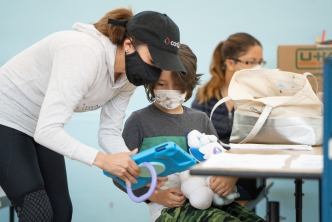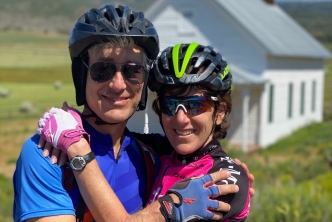Collaboration: In conversation with Susan Ford Dorsey
Magnify Community recently met virtually with Susan Ford Dorsey, Magnify Community Pledger and long-time philanthropist, to discuss the power of collaboration and partnership in philanthropy. (Comments have been condensed and lightly edited for clarity.)
What’s the history of the Sand Hill Foundation and how do you direct your giving?
The Sand Hill Foundation was started by my late husband Tom Ford and me in 1995, so it's really been around for quite a while. It was founded on this principle of local giving. Tom was a very pragmatic person who felt it was important to give where we lived and worked. So from the very beginning, we were very much of a place-based foundation serving San Mateo County and northern Santa Clara County. It has always been a very satisfying principle because you get to know the people who do the work here. You get to know the nonprofit leaders, you get to know the community really well and the sense of satisfaction of actually making a difference.
What does it mean for you to be an effective place-based funder?
We have always been a responsive foundation, which means listening to what the community has to say about their needs and then responding to that. Sometimes, you know, a food bank or a local food emergency organization simply needs a new refrigerator. They don't need a strategic plan. They don't need something more complicated. They need a refrigerator in order to meet the needs of the community. It's sometimes as straightforward as that. But sometimes, and after you've been doing this for a while like we have, you begin to see patterns. You begin to see things that could be enhanced or improved if people work together – that's both on the funder side as well on the grantee side. You’re positioned to see how the pieces fit together to see how to get to a better impact.
Donors often talk about collaboration, but you’ve helped make it happen. Tell us about that.
Several years ago, we started with a collaborative in the after school time space. There are a number of organizations in our community that do a fantastic job of tending to kids who need that extra support, who are wanting to be the first in their family to go to college, like the Boys and Girls Club, College Track, and Peninsula Bridge, and so many others. We put together a group of nine of those after school programs and the CEOs. They met quarterly and they worked on some projects together and it was really quite successful. And it was actually quite telling how little they actually knew about each other. At the end of our time together after six years–though they wanted to continue to meet–it was clear who was doing a great job in terms of human resources, software, or activities, and who had a really great evaluation system or a wonderful way of working with the parents. They all benefited. We were joined in that effort by the Packard Foundation and the Sobrato Foundation, so that was a good example of working together with other funders, too.
We decided recently to take on the youth mental health area and have put together a different kind of model. It's called the Wellness Partnership. There are five different groups of organizations that work on different aspects of youth mental health. The five groups are our partners, and within those five groups, there are various organizations. For example, there's Friends for Youth, the Police Activities League, and the Siena Youth Center from St. Francis Center. They are their own group and they focus on working together. So there's the grassroots kind of activities that go on in identifying kids who are in need of mental health services, and then it goes up the chain to StarVista that provides the actual therapy. Our theory has been borne out that these are groups that were aware of each other, but hadn't worked together, and they are amplifying the impact that they can have by working in concert and identifying new groups of kids who need services.
What are you learning and how has that prompted you to “go bigger” with your grants to the collaborative?
It's still pretty young–I think we're now in our second year–but we’re very pleased with the results. We have an outside third-party evaluator and they already have their first-year analysis. The early indications are that more and different kids are being identified. For example, there was not a screening tool at the homeless shelters at Haven House [in Menlo Park] or anywhere at LifeMoves that could help identify young people in need. Palo Alto University, through the Partnership, has provided that and has provided the links to counseling. So there's some really specific examples of how the system is being improved to integrate mental health prevention, screenings, and referral services, and create access points where they may not have existed before. When you multiply that across five partnerships and 27 different organizations, you can really see the impact. So our grants have gone up from $50,000 average. These grants are $200,000 for each year for two and three years. So they're much bigger bets. They're much more intricate and they require much more of our work compared to our responsive gifts. They also require additional work for the nonprofits who are our partners, because partnerships to serve clients in a more comprehensive way can’t be developed overnight. We wanted to fund collaboration capacity, to support new partnerships and new ways of working together. And we're really, really thrilled so far with the results.
What’s next for the Wellness Partnership?
COVID hit at the wrong time for all of us and for the Wellness Partnership, since it has kept us from seeking other partners very actively. But that's okay. We can continue with our current grantees and, though we needed to halt our plans for expansion in 2020, we will be launching a new round of funding in 2021 because this need is not going to go away. Fostering these cross-organizational relationships is really important. We’re very excited about the Wellness Partnership and welcome other funders to join us in supporting teen mental health in San Mateo County.


